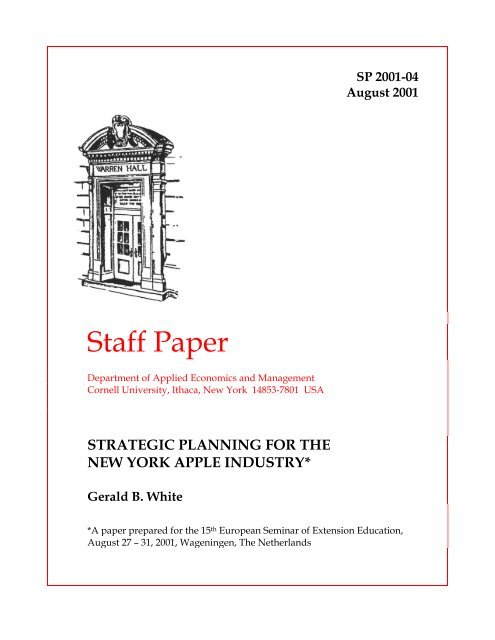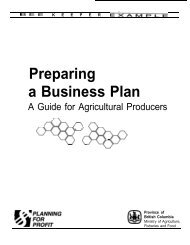Gerald B. White - Agricultural Marketing
Gerald B. White - Agricultural Marketing
Gerald B. White - Agricultural Marketing
Create successful ePaper yourself
Turn your PDF publications into a flip-book with our unique Google optimized e-Paper software.
Staff Paper<br />
Department of Applied Economics and Management<br />
Cornell University, Ithaca, New York 14853-7801 USA<br />
STRATEGIC PLANNING FOR THE<br />
NEW YORK APPLE INDUSTRY*<br />
<strong>Gerald</strong> B. <strong>White</strong><br />
SP 2001-04<br />
August 2001<br />
*A paper prepared for the 15 th European Seminar of Extension Education,<br />
August 27 – 31, 2001, Wageningen, The Netherlands
It is the policy of Cornell University actively to support equality of educational<br />
and employment opportunity. No person shall be denied admission to any<br />
educational program or activity or be denied employment on the basis of any<br />
legally prohibited discrimination involving, but not limited to, such factors as<br />
race, color, creed, religion, national or ethnic origin, sex, age or handicap.<br />
The University is committed to the maintenance of affirmative action<br />
programs which will assure the continuation of such equality of opportunity.
Strategic Planning for the New York Apple Industry<br />
The author was involved in strategic planning for the New York apple industry, a process that<br />
began in the Spring of 2000. The industry was beset by negative economic performance<br />
resulting from a series of factors such as a world over-supply of apples in relation to demand;<br />
depressed prices for apples utilized for juice due to the effects of China selling apple juice<br />
concentrate (AJC) at prices below the cost of production; severe weather events such as hail<br />
storms in 1998 and 2000; and increasing concentration in the retailing sector that constrained<br />
access to markets in major retail chains. The combination of these events led to four consecutive<br />
years of declining prices that had the effect of reducing growers’ equity and placing perhaps 20<br />
per cent of the state’s approximately 700 apple growers in vulnerable positions for survival. The<br />
extreme economic hardship faced by growers signaled clearly to industry leaders that major<br />
changes were needed for the industry to survive and prosper in the future.<br />
The idea of conducting the Strategic Planning process was conceived by George Lamont, the<br />
General Manager of Lamont Fruit Farm, Inc., Albion NY and Darrel Oakes of LynOaken Farms,<br />
Inc., Lyndonville, NY. The idea grew out of a Variety Committee, with the realization that the<br />
state’s industry needed to address a much broader array of issues than just varieties to deal with<br />
the current situation. The strategic planning process was supported by two grower’s associations<br />
(the New York Apple Association and the New York Horticultural Society), the New York State<br />
Department of Agriculture and Markets, and by Cornell University through the Fruit Statewide<br />
Program Committee. The expenses for meetings were paid for by an account of $2,000<br />
established by the Department of Agriculture and Markets, while administrative expenses such<br />
as communications were covered by Lamont Fruit Farm, Inc.<br />
A task force comprised of 26 persons was organized. These included representatives of the<br />
supporting organizations mentioned above, grower representatives from the major producing<br />
regions in the state and apple storage operators/packers/marketers. In addition, representatives<br />
from the following organizations were task force members: a major retail chain, an organization<br />
that supports the development of agriculture in New York, the state’s major apple processing<br />
company, Farm Credit, and the Market Order Administrator for the New York State Department<br />
of Agriculture and Markets. George Lamont served as Chair of the Task Force. George had<br />
recently semi-retired from his duties with Lamont Fruit Farm, Inc. (in part, due to the economic<br />
crisis in the industry which forced the operation to down-size its management team). This was<br />
an important point since having less responsibility with the home operation gave him the<br />
considerable time required to lead the strategic planning process. Nathan Rudgers, the<br />
Commissioner of New York State Department of Agriculture and Markets, served as Honorary<br />
Chair. For a list of Task Force members, see Appendix 1.<br />
The first meeting of the task force was held on April 20, 2000 in Little Falls, NY. Commissioner<br />
Nathan Rudgers of the New York Department of Agriculture and Markets set the stage by<br />
discussing the mission and vision of his agency, and by noting the need for the apple industry to<br />
strategize to adapt to tremendous changes in the marketing system, new opportunities opening<br />
up, and some opportunities closing. Commissioner Rudgers’ point line was “Time is of the<br />
essence.” Dr. Jerry <strong>White</strong> of the Department of <strong>Agricultural</strong>, Resource, and Managerial
Economics (ARME) at Cornell University, presented an analysis of Trends in the New York<br />
Apple Industry. Emphasis was placed on changes in the retailing sector, increasing competition<br />
from Washington state, and the resulting impacts on the profitability of New York growers (see<br />
<strong>White</strong>, 2000). Dr. Bruce Anderson of ARME facilitated an analysis of strengths, weaknesses,<br />
opportunities and threats (SWOT analysis) facing the New York industry. Alternatives that<br />
would address problems in the industry were discussed. The first drafts of a vision and mission<br />
statements and objectives were formulated.<br />
• In May and June, 2000, a series of meetings was held in five regions of the state to involve<br />
growers and solicit input from a cross section of the industry. These meetings were<br />
important in that they helped to build ownership for the process among various segments of<br />
the industry. A meeting for storage operators, packers and marketer was held in June for the<br />
same purpose. Building support among participants in the marketing chain “beyond the farm<br />
gate” is essential. If marketers do not support the industry plan that ultimately results from<br />
the process, it will not be implemented because of their influence that comes from being<br />
marketers of the growers’ fruit. Meeting dates, location and attendance are indicated in<br />
Table 1.<br />
Table 1. Meeting dates, locations and attendance, regional meetings.<br />
31 May Knowlesville 53<br />
12 June Wolcott 63<br />
13 June Saratoga Springs 13<br />
13 June Peru 9<br />
19 June Highland 33<br />
Total attendance: 171<br />
21 June -Meeting for storage operators and Marketer representatives, Utica NY<br />
(Attendance: about 25)<br />
A second meeting of the task force was held on June 28, 2000 in Little Falls, NY. Dr. Win-fei<br />
Uva of the Department of ARME reviewed the five regional meetings that had been held in the<br />
previous month. The comments from growers and other attendees at these meeting revolved<br />
around four areas: profitability, quality, market structure (including the fragmentation of the NY<br />
industry), and marketing alternatives. Dr. Bruce Anderson reported on the meeting of the<br />
storage operators and marketers held on June 21. Quality was designated as the top problem, and<br />
yet there had been no agreement on solutions; too much inefficiency and too many<br />
uncoordinated efforts were hampering the industry. Commissioner Rudgers praised the efforts<br />
by the industry to date for its positive approach to the planning process, and promised to support<br />
the implementation of the final plan by making the appropriate statutory or regulatory changes<br />
that would help the industry move forward. Major emphasis for the remainder of the meeting<br />
was placed on developing consensus for alternatives to address the major opportunities and<br />
threats. Alternatives coalesced around four issues.<br />
2
The following committees were formed to formulate recommendations for the next task force<br />
meeting:<br />
Quality - Chair: Bill Gerling<br />
Market Structure (reducing fragmentation) –Chair: Jim Kankowski<br />
Technology/varieties – Chair: Darrell Oakes<br />
New Products and Markets – Chair: Joe Nicholson<br />
At a third meeting of the task force on November 8, 2000 in Little Falls, the four committees<br />
reported their recommendations. There were a total of nearly 40 recommendations from the four<br />
committees above. Alternatives (“action plans”) were prioritized by committees. Much<br />
attention was placed on the report of the Market Structure committee which proposed an Apple<br />
<strong>Marketing</strong> Association (a cooperative of producers/packers/marketers) to improve quality,<br />
disseminate market information, improve communication among marketers, and to provide a<br />
legal structure for price discovery. The Task Force directed the Market Structure Committee to<br />
rethink the recommendation of forming a new organization, as many thought the industry already<br />
had enough organizations. Kristin Rowles, Research Support Specialist in ARME, gave a<br />
progress report on the Value Added Processing Apple project, in which marketing surveys and<br />
focus groups were being conducted. (See Rowles, Henehan, and <strong>White</strong>, 2001 for a final project<br />
report of this research). A draft of the strategic plan incorporating the results of previous<br />
meetings was discussed and refined.<br />
A fourth meeting on December18, 2000 in Little Falls, NY was necessary to complete the<br />
process of refining and prioritizing action plans. The Market Structure Committee reported that<br />
after more deliberations, it recommended that the New York Apple Association should retain its<br />
mission as it existed, and that a new organization should be formed. This organization was<br />
called “APCO,” or Apple Cooperative. A revised draft of the strategic plan was approved for the<br />
Forum, a meeting at which the industry would review the strategic plan for final approval, in<br />
January.<br />
On January 9, 2001, a key meeting of storage operators, packers, and marketers was held in<br />
Little Falls, NY to discuss the draft strategic plan, gain input for the final draft, and to develop a<br />
consensus for the plan. Much time was spent on two of the committee reports. Chair Jim<br />
Kankowski of the Market Structure Committee reported on the proposed structure and<br />
functioning of APCO, the cooperative that later was named Premier Apple Cooperative. Bill<br />
Gerling, Chair of the Quality Committee, led a discussion of the recommendations of that<br />
committee, especially with respect to solving the condition problem, which was seen as the key<br />
to improvement of the quality of New York apples.<br />
An industry forum, involving all segments of the apple industry, was held on January 30-31,<br />
2001 in Syracuse, NY to present the final draft plan. Recommendations for four organizations<br />
(the Apple Cooperative, the New York Horticultural Society, the New York Apple Association,<br />
and Cornell University (and Cornell Cooperative Extension) were presented and approved. By<br />
most accounts, the outcome of the meeting was a huge success. Industry representatives at the<br />
meeting basically approved the strategic plan that had been developed through the process and<br />
gave their consent to the priority tasks (“action plans”) passed along to the four relevant<br />
3
organizations. Twenty-nine recommendations were approved, and each was assigned to an<br />
“action organization” to carry out. Most of the dissent revolved around the point that, although<br />
processing accounts for about 55 per cent of the utilization of the state’s apples, some thought<br />
that there was too little emphasis given to action plans to deal with processing products. (The<br />
Strategic Plan adopted at the forum is in Appendix 2. The action plans for the four organizations<br />
may be seen in Appendix 3). The action plan for the Premier Apple Cooperative includes<br />
improved communications, collection and dissemination of marketing information, quality<br />
improvement, and enhanced grower returns.<br />
A final meeting of the task force was held on June 21 in Little Falls, NY. The four “action<br />
organizations” reported on their progress in implementation of the 29 recommendations that had<br />
emerged from the industry forum. Almost all of the recommendations had either been carried<br />
out or were in progress. A discussion ensued about whether the task force was still needed. It<br />
was decided that the task force would need to meet annually in June. An executive committee<br />
would meet in the interim as needed to ensure that progress continues on the action plans.<br />
Epilogue<br />
At the time of writing of this report, implementation of the strategic plan is ongoing. The<br />
cooperative, Premier Apple Cooperative, Inc., was officially formed on June 19. Building<br />
membership and recruiting members for the Board of Directors are now the primary<br />
organizational tasks. A membership goal of 100 members at $100 per member has been<br />
established. George Lamont, who is now the Executive Director of the New York Horticultural<br />
Society, is preparing a monthly <strong>Marketing</strong> Newsletter (“to facilitate marketing communication<br />
and to collect and disseminate marketing information,” which were important functions of the<br />
cooperative’s mission). The Quality Committee continues to meet to develop quality standards.<br />
Being considered are minimum pressure test requirements for major varieties as well as brix<br />
standards. Almost all of the 29 approved recommendations been carried out, or are in process.<br />
The major longer-term objective is to enhance returns to growers. This ultimate test will be<br />
played out over the next few months as the respective organizations put their assigned action<br />
plans in place.<br />
The best conceived strategic planning process is not a success until implementation is well<br />
advanced. The New York industry is to be commended for the leadership that developed and the<br />
timely and effective process that resulted in the development of the plan. History, however, will<br />
judge this strategic planning process based upon the industry’s commitment to implementation of<br />
the plan, especially its most important components. At the end of the day, was fragmentation<br />
reduced in the state’s apple industry? Did the plan increase returns to growers and improve their<br />
long run prospects for survival?<br />
The author expresses appreciation to George Lamont for his careful review of this paper. Any<br />
remaining errors are the responsibility of the author.<br />
4
References<br />
<strong>White</strong>, G. B., 2000. “Trends in Apple <strong>Marketing</strong> and Impacts on NY Growers’ Profitability,<br />
New York Fruit Quarterly, Vol. 8, No. 2, pp.7 – 12.<br />
Rowles, K.L, B. M. Henehan, and G. B. <strong>White</strong>, 2001. Thinking Afresh About Processing: An<br />
Exploration of New Market Opportunities for Apple Products, Staff Paper 2001-03, Department<br />
of Applied Economics and Management, Cornell University, Ithaca NY 14853, 179 pp.<br />
5
Appendix 1<br />
New York Apple Industry Strategic Planning<br />
Task Force Members<br />
6
Appendix 2<br />
Final Strategic Plan<br />
8
Appendix 3<br />
Action plans for:<br />
APCO Cooperative<br />
New York Horticultural Society<br />
Cornell University<br />
New York Apple Association<br />
15
OTHER A.E.M. STAFF PAPERS<br />
Fee<br />
SP No Title (if applicable)<br />
Author(s)<br />
2001-03<br />
2001-02<br />
2001-01<br />
2000-07<br />
2000-06<br />
2000-05<br />
2000-04<br />
2000-03<br />
2000-02<br />
2000-01<br />
99-06<br />
99-05<br />
99-04<br />
Thinking Afresh About Processing: An Exploration<br />
of New Market Opportunities for Apple Products<br />
Industry Analysis: Apple Processors in the<br />
Northeastern U.S.<br />
Processed Apple Product <strong>Marketing</strong> Analysis:<br />
Apple Juice & Cider<br />
Estimating Risk - Adjusted Interest Rates for Dairy<br />
Farms<br />
Processed Apple Product <strong>Marketing</strong> Analysis:<br />
Hard Cider and Apple Wine<br />
Rowles, K., B. Henehan, and<br />
G.B. <strong>White</strong><br />
Rowles, K.<br />
Rowles, K.<br />
Tauer, L. W.<br />
Rowles, K.<br />
Commodity Prices Revisited Tomek, W.G.<br />
International Competition in the Greenhouse<br />
Production of Floriculture Products -- Lessons for<br />
New York and India<br />
Investment Analysis in Agriculture Tauer, L.W.<br />
Brown Tide, Bay Scallops and the Location of<br />
Spawner Sanctuaries in the Peconic Bays, New<br />
York<br />
Risk Management in <strong>Agricultural</strong> Markets: A<br />
Survey<br />
An Evaluation of Nutrient Management Planning<br />
and Impacts: French Creek Watershed,<br />
Chautauqua County, New York<br />
An Economic Analysis of Petroleum and Military<br />
Security in the Persian Gulf<br />
Agriculture in Sao Tome e Principe: Policy and<br />
Investment Options<br />
Mysore, S. and W.L. Uva<br />
Conrad, J.M. and K.C. Heisey<br />
Tomek, W.G. and H.H. Peterson<br />
Santos, C., W. Knoblauch and<br />
D. Gross<br />
Chapman, D. and N. Khanna<br />
Kyle, S.<br />
To order single copies of AEM publications, write to: Publications, Department of Applied Economics and Management, Warren Hall, Cornell<br />
University, Ithaca, NY 14853-7801. If a fee is indicated, please include a check or money order made payable to Cornell University for the amount of<br />
your purchase. Visit our web site: (http:/ /aem.cornell.edu) for a more complete list of recent papers.




